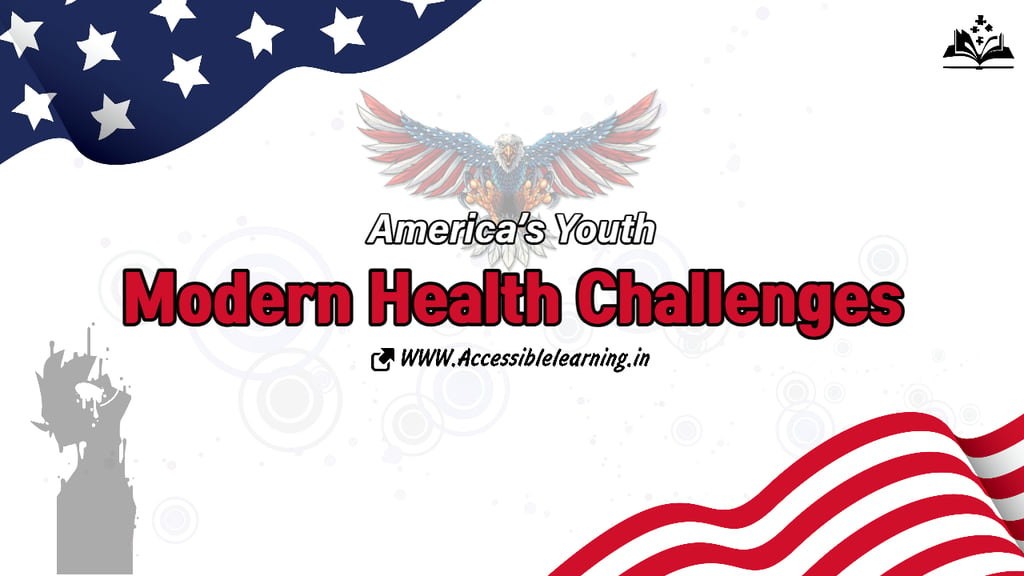
How Modern Lifestyles Are Affecting the Health of America’s Youth
Learn about the modern health challenges facing America's newest generation, including rising mental health issues, obesity, digital addiction, and more. Learn about causes and solutions to support better health in today's youth.
MODERN DISEASESHEALTH/DISEASENEW YOUTH ISSUESUSA
Sachin K Chaurasiya
7/4/20253 min read


In recent years, America's younger generation has faced unprecedented health problems due to modern lifestyle changes, social pressures, and environmental factors. From mental health crises to chronic diseases commonly seen in the elderly, the new generation is grappling with complex health challenges that require nuanced understanding and targeted solutions. This article discusses these serious health problems in depth, sheds light on their causes, and explores possible ways to improve.
The Mental Health Crisis!
The rise in mental health problems among young people is one of the most worrying trends in recent years. Anxiety, depression, and stress-related disorders are becoming increasingly common, with several factors responsible for this:
Influence of social media: Platforms such as Instagram and TikTok create unrealistic standards for beauty and success, leading to low self-esteem and body image issues. Constant comparison to curated images can increase feelings of inadequacy and anxiety.
Academic and career pressure: The competitive nature of the modern educational system and the job market places a great deal of pressure on young people. Fear of failure and uncertainty about the future contribute significantly to mental health problems.
Solutions
Addressing these issues requires increased mental health support, including access to counseling services and mental health education. Reducing stigma around seeking help and promoting a balanced approach to social media use can also play an important role.
Obesity and Sedentary Lifestyles!
Obesity rates are alarmingly high among the younger population, and sedentary lifestyles and poor dietary habits are at the root of this epidemic.
Dietary choices: The prevalence of fast food, sugary snacks, and processed foods contributes to unhealthy weight gain. Limited access to nutritious foods in some areas further exacerbates the problem.
Lack of physical activity: Many young people spend hours staring at screens while not making enough time for physical activity. This sedentary behavior is linked to a variety of health problems, including obesity and related chronic diseases.
Solutions
Encouraging physical activity through sports and outdoor activities as well as promoting healthy eating habits can help fight obesity. Schools and communities should focus on creating environments that support healthy lifestyle choices.
Digital Addiction?
The rise of digital technology has created new health challenges, especially for young people:
Sleep disorders: Spending too much time in front of a screen, especially before bedtime, disrupts sleep patterns and contributes to insomnia. The blue light emitted by screens can disrupt the body’s natural sleep-wake cycle.
Physical stress: Prolonged use of digital devices can cause eye strain, headaches, and poor posture, which can lead to musculoskeletal problems in the long term.
Solutions
Enforcing screen time limits and promoting good sleep hygiene can help reduce the negative effects of digital addiction. Regular breaks from screens and ergonomic adjustments can also reduce physical stress.
Substance Abuse!
Substance abuse remains a significant issue among America's youth, and new trends and substances are affecting health outcomes!
Vaping: E-cigarette use has increased, with many young people unaware of the potential health risks. Vaping can cause respiratory problems and serve as a gateway to traditional smoking or other substances.
Opioid crisis: The opioid epidemic has spread to the youth population, with prescription drug abuse and heroin use posing serious health risks.
Solutions
Education about the risks of vaping and substance abuse, as well as increasing access to prevention and treatment programs, is essential. Support systems and early intervention can help address these issues effectively.

Chronic Conditions at a Young Age!
Long-term health problems that were previously uncommon in the younger population are now becoming more prevalent:
Type 2 diabetes: Linked to obesity and poor dietary habits, type 2 diabetes is increasingly being diagnosed in children and adolescents.
Cardiovascular problems: Sedentary lifestyles and unhealthy diets are contributing to cardiovascular problems such as high blood pressure and high cholesterol in young individuals.
Solutions
Promoting healthy eating and regular physical activity is important for preventing and managing chronic diseases. Public health initiatives and educational programs can help raise awareness and support healthy lifestyles.
Environmental and Climate-Related Health Issues!
Environmental change and climate factors are affecting the health of youth in new ways:
Air pollution: Poor air quality, especially in urban areas, contributes to respiratory problems such as asthma. Young people are particularly vulnerable to the effects of pollution.
Climate anxiety: Concerns about environmental degradation and climate change can lead to mental health problems, such as eco-anxiety and stress about the future.
Solutions
Addressing environmental health issues involves both individual and policy-level action. Supporting clean air initiatives and providing mental health support related to environmental concerns are important steps.

Sexual & Reproductive Health!
Sexual and reproductive health concerns are increasingly prominent among young people:
Sexually transmitted disease rates: Rates of sexually transmitted diseases such as chlamydia and gonorrhea are increasing. Inadequate sex education and risky behaviors contribute to these trends.
Education and access: Many young people lack access to comprehensive sex education and health services, leading to misinformation and health risks.
Solutions
Comprehensive sexuality education and increasing access to health services are crucial to improving sexual and reproductive health. Open communication and education can help young people make informed decisions.
America's new generation faces a complex range of health challenges influenced by modern lifestyle changes, environmental factors, and social pressures. Addressing these issues requires a multifaceted approach, including improved mental health support, healthy lifestyle promotion, and effective education. By fostering environments that support physical and mental health, we can help ensure a healthy future for younger generations.
Subscribe to our newsletter
All © Copyright reserved by Accessible-Learning
| Terms & Conditions
Knowledge is power. Learn with Us. 📚


